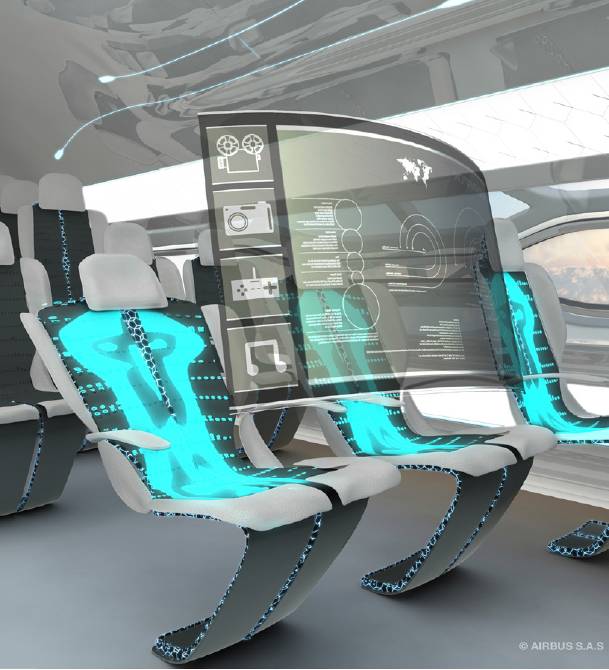AIR TRANSPORT Smart passenger cabins
Conscious cabins
Cranfield University is inviting debate on how future intelligent aircraft cabin systems
could be used to assist and care for airline passengers. BILL READ FRAeS analyses some of
the proposed ideas and how passengers might react to them.
 Cabin with a soul – You think you’ve got problems? You should try being a cabin.
Cabin with a soul – You think you’ve got problems? You should try being a cabin.
You are a passenger of the future. Boarding your green environmentally efficient aircraft, you take your
place in your ultra lightweight economy seat – it is a little hard – and admire the HD virtual scenery
projected on the walls of the windowless cabin. After take-off you are then free to enjoy the delights of
the latest virtual reality IFE system. Putting on your headset and inserting your earplugs to reduce the
noise from other passengers, you use hand gestures to take you on a 3D tour of your destination followed by
an action film in which you are the hero – although it is a little difficult to fight with your lightsaber
when are confined to your seat.
Don’t get too warm from your virtual exercise or the cabin body heat detectors may think you have an
infection and trigger an alarm. You use the IFE system to order a cooling drink but don’t have too many or
the machine will tell the cabin crew. Time to talk to a fellow passenger elsewhere in the aircraft but don’t
worry – you won’t disturb your neighbours as they won’t be able to hear you. Then relax and enjoy the
quietness of the cabin as you look out through the side of the aircraft and see the passing landscape –
augmented with extra geographical information – and muse on how much better your passenger flight experience
is now than it was in the past.
This vision of the future could one day be reality as new technology enables the introduction of intelligent
aircraft cabins which can interact with passengers. However, would these new systems improve the passenger
experience or detract from it?
Greener, safer and happier
Among the many webinars at the FIA Connect virtual Farnborough Air Show event in July was a presentation on
Future Cabin Design by Dr Thomas Budd from Cranfield University.
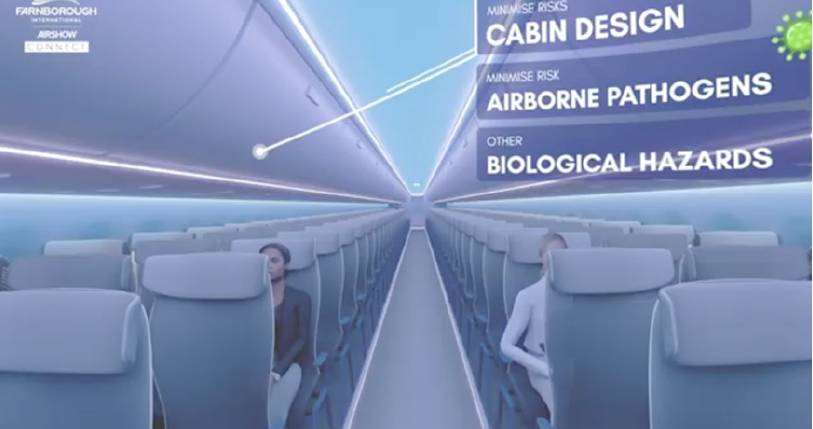 Watch out – Conscious aircraft, caring for both the aircraft and you.
Watch out – Conscious aircraft, caring for both the aircraft and you.
Using graphics created in Cranfield’s Passenger Experience Laboratory at DARTeC (Digital Aviation and
Research Technology Centre), in which users can explore a 3D simulation of an aircraft cabin, Dr Budd showed
how the aircraft cabin of the future might use new and emerging technologies to revolutionise the onboard
passenger experience and make air travel more sustainable for future generations. The intelligent aircraft
cabin is part of a wider vision of creating a ‘conscious aircraft’ which would monitor its own health and
predict when components and systems need to be replaced. Dr Budd explained how the purpose of the future
cabin design demonstration was to spark interest and debate into what the future cabin experience may (or
should) look like in the future.
Dr Budd explained how a flight represents a critical part of a traveller’s door-to-door journey and a good
travel experience can make a refreshing and energising start to a holiday or business trip, whereas a
stressful one makes the flight an experience that has to be ‘endured rather than enjoyed’.
The presentation focused on how different advances in technology could be used in the aircraft cabin to
monitor passengers, partly with the intention of enhancing their enjoyment of the flight and partly with a
wider focus to improve the overall safety of all the passengers aboard the aircraft. There was also a drive
to reduce the environmental impact of aviation.
The intelligent cabin doctor will see you now
 VR headset – Don’t interrupt me, I’m in my own virtual world!
VR headset – Don’t interrupt me, I’m in my own virtual world!
Following the Covid-19 crisis, more attention is being paid to passenger well-being and the prevention of future
pandemics through bio-safety measures. Consequently, there is an urgent need to address the role of cabin design
to minimise the risk of airborne pathogens and other biological hazards. Technology will have a key role to play
in addressing these challenges.
Dr Budd described how three key factors to minimising passenger fatigue and the effects of jet lag are: to be
well-hydrated, to stay active and to get rest. By using a network of strategically positioned sensors, the smart
or conscious cabin can monitor a passenger’s physiological state throughout a flight, including body
temperature, pulse and hydration levels. This can also be useful for health screening purposes. If desired,
passengers could choose to receive automatic alerts and notifications with advice on their requirements in
advance of actual need.
Big airline is watching you
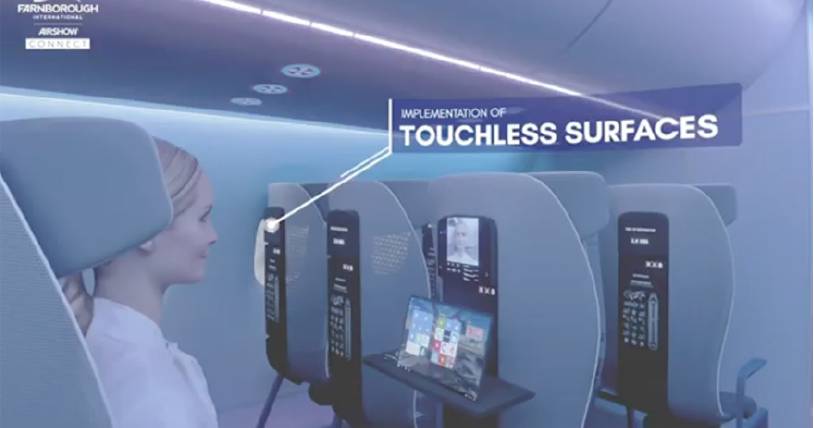 Touchless surfaces – Look but don’t touch. Hands-free gesture controls are already being used for smart home devices, games and cars. All images courtesy of Cranfield University
Touchless surfaces – Look but don’t touch. Hands-free gesture controls are already being used for smart home devices, games and cars. All images courtesy of Cranfield University
Accepting the invitation to comment on the proposals, it could be said that the introduction of an ‘intelligent
cabin’ monitoring passengers’ vital signs might not necessarily be welcomed by passengers, some of whom might
not be comfortable with increased intrusion into their privacy. While monitoring the temperatures of individual
passengers would seem to be a wise move as long as Covid-19 is around, there are also other issues which need to
be addressed. Could passengers choose not to be monitored? Would there be circumstances where passengers were
unaware that their health signs were being remotely scrutinised in this way? If the sensors are triggered by
body heat, might there be a risk of the sensors being triggered accidently or even giving a false reading? What
might happen if the cabin heating malfunctions or the aircraft is stuck on a taxiway and the passengers get hot
and thirsty?
There is also the question of data privacy. Who on the aircraft would get to see the passenger health screening
information? Would it be a member of cabin staff or would the data also be shared with the airline? Would the
passenger health information be deleted after the flight or would it be recorded to use in big data surveys or
reused for future flights? Where would this data be kept and would it be secure? Would passengers be allowed to
see their own data under GDPR rules? Would passengers be refused flights because they triggered an alarm in a
previous flight?
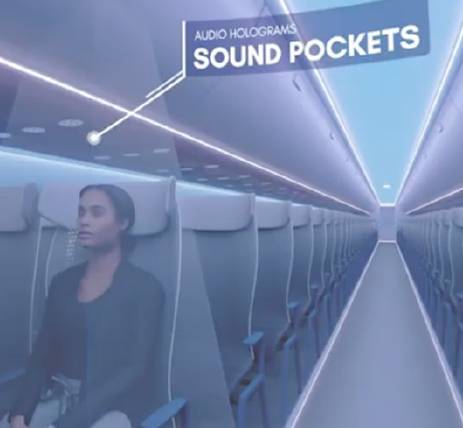 Sound pockets – I’m in my personal sound pocket and I’m not listening to you.
Sound pockets – I’m in my personal sound pocket and I’m not listening to you.
No smoking or drinking
Returning to Dr Budd’s presentation, he described how, working alongside the traditional cabin control systems
which supply air supply, thermal control and cabin pressurisation, ultra-sensitive chemical sensors could also
be used to detect the presence of unwanted particles, including smoke or exhaust gases, specific physiological
markers (for example if someone has been drinking too much alcohol) and pathogens (to help prevent the spread of
viruses or infectious diseases). If predetermined levels or certain substances were exceeded, notifications
could be sent to cabin crew to alert them to a potential problem.
Alcoholics not so anonymous
Once again, this proposal to use the aircraft systems to remotely monitor passengers could lead to problems.
Smoke detectors are already fitted in areas such as the aircraft toilets which makes sense from a safety point
of point, as these are areas where passengers cannot be seen by cabin crew. However, it is more debatable
whether it is necessary to use technology to detect drunken passengers when the job could just as easily be done
by a member of cabin crew.
Legal implications
The question might also be asked as to the legal implications of using technology to monitor passengers which
might be construed as interfering with their personal privacy? Some passengers are already very keen to post
derogatory messages on social media or sue airlines for alleged misdemeanours and the introduction of
intelligent cabin monitoring might serve only to increase this trend.
Enhanced IFE
Another key focus of future aircraft cabins, according to Dr Budd, is that of in-flight entertainment (IFE) which
will remain an important part of the travel experience, especially for long-haul travel. Advances in VR (virtual
reality), AR (augmented reality) and XR (cross-reality) immersive technologies are likely to represent key
trends. With virtual reality capabilities integrated into the IFE system with an appropriate headset, it could
be possible for passengers to virtually transport themselves to somewhere else entirely. As well as watching
films, passengers could also experience the sights and sounds of their destination before they arrive, plan
their onward journeys or explore the destinations they are currently flying over with an immersive 360º
experience.
Confined reality
While the idea of using virtual reality to escape from the reality of long-distance air transport sounds
promising in theory, the actual experience may be less than optimal. VR headsets can create the illusion of
being in a different world if you can walk about and interact with things but would this work when you are
confined to an aircraft seat? Also, to use the systems, passengers would have to wear a VR headset which would
run the risk of them being unaware of what was happening in the aircraft cabin space if another passenger wanted
to get out into the aisle or the cabin staff want to serve meals. Being enclosed in a VR headset would also not
improve the travel experience of passengers who do not enjoy the experience of sitting in the restricted space
of an aircraft.
Touchless control
There is also the issue of control. Currently, seatback IFE systems are operated using touch controls – which is
not such a good idea in a world with Covid-19 where the surfaces could become infected and spread between
passengers. If Covid-19 is here to stay, then future IFE systems are being proposed which incorporate touchless
controls operated by simple motion or hand gestures which would remove the need for passengers to come into
contact with each other indirectly.
A recipe for air rage?
Gesture control is already used for applications for personal home devices, TVs, computer games and car security
and is being developed for pilots of military aircraft who need fast control of a manoeuvring aircraft. However,
the question might be asked as to whether such a system would be suitable for a civil aircraft with hundreds of
passengers. While it would be easy for a machine to detect a gesture from a single military pilot, could an IFE
system also detect an individual signal from a passenger sitting in close proximity to other passengers where
you are bunched so tightly together that you have limited arm movement?
IT WOULD BE POSSIBLE TO REDUCE AIRCRAFT WEIGHT AND IMPROVE AERODYNAMIC EFFICIENCY BY HAVING
AIRCRAFT WITHOUT EXTERIOR WINDOWS, WHICH WOULD PROJECT REAL TIME HD IMAGES OF THE OUTSIDE VIEW ONTO THE SIDE OF
THE CABIN
But would anyone want to fly in one? Certainly not passengers who suffer from claustrophobia and feel
uncomfortable even in an aircraft cabin with windows. It would also not be popular with agoraphobics who suffer
anxiety in situations where there is no means of escape or with passengers afraid of heights who find themselves
sitting next to the edge of a great height. At least with a window you get a choice of whether or not to look
out of it. There are also safety implications in that there would be no natural light if the cabin lights fail
or if light is needed for an emergency evacuation.
Weight savings
Weight savings could also be achieved by using advanced lightweight materials, such as aerogels, sound
insulation, heat insulation, metal foams and lattices and other meta-materials that offer unique properties by
combining the effects of topology and microscopic structure. These materials could be used in any cabin product,
including seats and insulation panels.
The risk with these designs is that the desire for airlines to reduce weight may come at the expense of passenger
comfort. A lightweight seat is often also an uncomfortable seat.
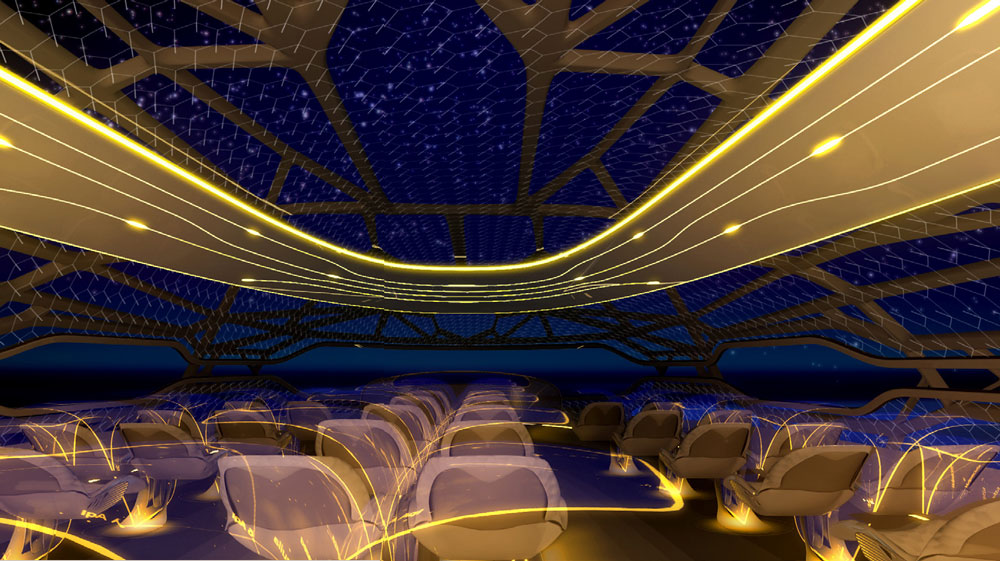 Future cabins as imagined by Airbus. Airbus
Future cabins as imagined by Airbus. Airbus
Cabins with a soul
Dr Budd concluded by describing the development of future intelligent cabin systems as a ‘true revolution in the
way passengers experience air travel which could be achieved if cabins were fitted with a ‘soul’ – the ability
to feel, understand and adapt to different groups of passengers aboard at any given time’.
The aim would be to ‘provide passengers with a more personal, tailored in-flight experience to achieve the
highest level of passenger satisfaction’. With the future systems integrated with other onboard systems, such as
IFE, for enhanced passenger well being, further capabilities for the state, trait and needs of individual
passengers could also be introduced, including improved services for passengers with unseen disabilities.
Flying nearer to heaven or hell?
But would this objective be achieved? What seems to have been omitted from this vision of the future is that not
all passengers want to talk to other passengers or to have their temperatures monitored. Some passengers might
just want to be left alone. Not all passengers would have their flight experience enhanced with virtual reality
IFE and might prefer to use their own laptops, read a book or to sleep? For passengers with unseen disabilities,
what would an intelligent cabin system provide that would not be better dealt with by human cabin crew?
Stimulating debate
Dr Budd is welcoming comments on the pros and cons of the intelligent cabin proposals. This invitation to debate
is a welcome move so that developers of systems which interact with passengers can avoid the risk of
implementing new technology for technology’s sake. Human elements need to be taken into consideration, as well
as issues of privacy and confidentiality. New technology can do amazing things but don’t forget the human in the
machine.
 Cabin with a soul – You think you’ve got problems? You should try being a cabin.
Cabin with a soul – You think you’ve got problems? You should try being a cabin.
 Watch out – Conscious aircraft, caring for both the aircraft and you.
Watch out – Conscious aircraft, caring for both the aircraft and you.



